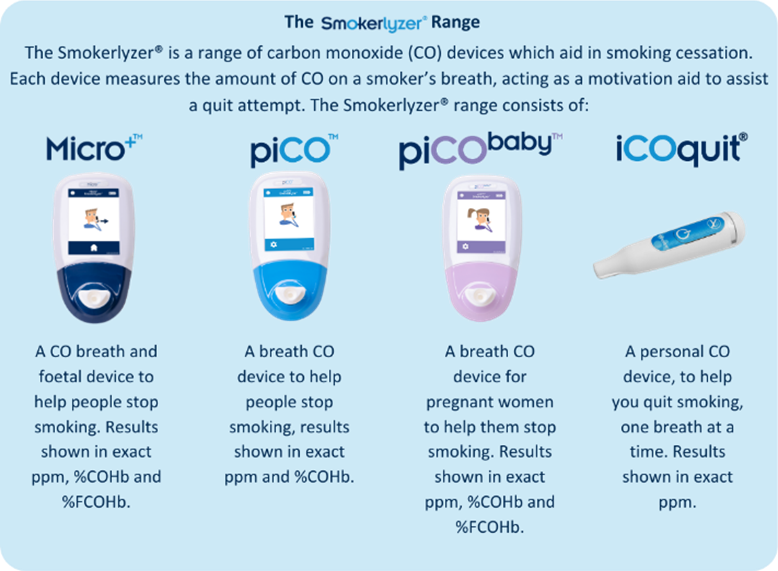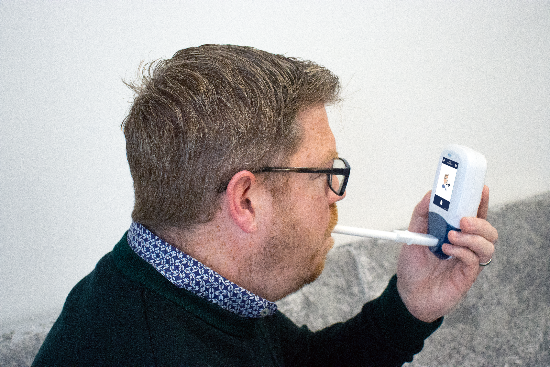Smoking tobacco produces carbon monoxide (CO), a harmful gas formed through incomplete combustion. Each year, smoking causes more than 8 million deaths and remains one of the most serious public health threats the world has ever faced.1 This figure includes approximately 1.3 million non-smokers exposed to second-hand smoke.1 Smoking severely impacts human health, affecting almost every organ in the body and leading to various diseases.
In light of these alarming statistics, this article investigates the role of CO monitoring in supporting smoking cessation.

Image Credit: Bedfont® Scientific Ltd
What is CO, and why is it harmful?
Carbon monoxide (CO) is a colorless, odorless gas in cigarette smoke. When inhaled, it is absorbed into the bloodstream through the lungs. CO attaches to haemoglobin in red blood cells, blocking their ability to carry oxygen and depriving the body of this vital nutrient. This can lead to a variety of health complications and smoking-related diseases, including:2
- Cancer
- Breathing and chronic respiratory conditions
- Heart disease, stroke, and blood circulation problems
- Diabetes
- Many other serious illnesses
The impact of smoking is profound, with smoking-related deaths remaining the UK’s leading cause of preventable mortality, causing 1 in 4 cancer-related deaths and 64,000 deaths annually in England.3
How CO monitoring works
CO monitoring is a simple, non-invasive technique used to measure CO levels in exhaled breath. While small amounts of CO are naturally present in the breath, smokers exhale higher levels due to CO inhalation during smoking.
Devices such as the Smokerlyzer® allow instantaneous CO level monitoring by having the user blow into the device.

Image Credit: Bedfont® Scientific Ltd
Why is CO monitoring useful for smoking cessation?
CO monitors such as the Smokerlyzer® benefit patients on their journey to quit smoking by delivering immediate feedback on smoking-related CO levels. Observing a reduction in CO levels after quitting can be a strong motivator, reinforcing commitment to cessation efforts.

Image Credit: Bedfont® Scientific Ltd
A study by Beard and West (2012) investigating the efficacy of personal carbon monoxide monitoring discovered that out of 10 smokers, “7 of the smokers reported that they felt as though the devices had reduced their cigarette consumption… 6 smokers reported a lower nicotine dependency relative to baseline. Over the 6 weeks, there appeared to be a significant decline in the number of cigarettes smoked per day”.4
Given that smoking is responsible for over 8 million deaths annually, more must be done to aid smoking cessation and reduce the global burden of smoking-related illnesses on healthcare providers. CO monitoring is a proven tool that helps individuals quit smoking and regain control of their health.
References and further reading
- World Health Organization (2023). Tobacco. (online) World Health Organization. Available at: https://www.who.int/news-room/fact-sheets/detail/tobacco.
- Department of Health and Aged Care (2024). Effects of Smoking and Tobacco. (online) Australian Government Department of Health and Aged Care. Available at: https://www.health.gov.au/topics/smoking-vaping-and-tobacco/about-smoking/effects.
- GOV.UK (2023). Prime Minister to create ‘smokefree generation’ by ending cigarette sales to those born on or after 1 January 2009. (online) GOV.UK. Available at: https://www.gov.uk/government/news/prime-minister-to-create-smokefree-generation-by-ending-cigarette-sales-to-those-born-on-or-after-1-january-2009.
- Beard, E. and West, R. (2012). Pilot Study of the Use of Personal Carbon Monoxide Monitoring to Achieve Radical Smoking Reduction. Journal of Smoking Cessation, 7(1), pp.12–17. https://doi.org/10.1017/jsc.2012.1.
About Bedfont Scientific
Bedfont® Scientific has specialised in the design and manufacture of exhaled breath and gas monitoring instruments since 1976.
For medical gas monitoring, their Medi-Gas Check medical pipeline testing range verifies not only the quantity but also quality of gas administered to patients.
Bedfont's breath analysers include carbon monoxide (CO) monitors such as the Smokerlyzer®, used for smoking cessation, and the ToxCO®, used by emergency services, to diagnose CO poisoning.
The NObreath® FeNO monitor provides accurate analysis of airway inflammation for the control of asthma, and the Gastrolyzer® range aids in the detection of gastrointestinal disorders and food intolerances. Quick and non-invasive, breath analysis is the new blood test.
Sponsored Content Policy: News-Medical.net publishes articles and related content that may be derived from sources where we have existing commercial relationships, provided such content adds value to the core editorial ethos of News-Medical.Net which is to educate and inform site visitors interested in medical research, science, medical devices and treatments.